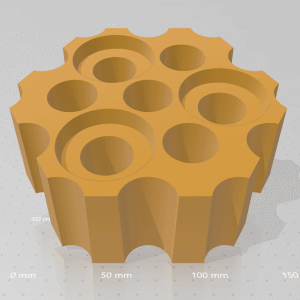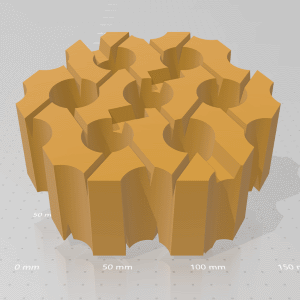The new type of chequer brick and checker-structure is an application of bionics and mimics the structure of an animal's body, i.e. the marine sponge.
The circulation of gases in the regenerators of cowpers through independent vertical channels is replaced by a 3D labyrinth that also contains horizontal connecting channels joining all twelve vertical holes of any chequer brick in the structure.
In the September 10, 2006 issue of USA Today, the famous Nobel laureate, physicist Richard Feynman named turbulence as the most important still unresolved problem in classical physics. No one really understands the transition from a smooth to a turbulent flow of a gas. The problem here involves even the mathematical theories of the study of chaos. This is confirmed by the considerable size of the transient zone between laminar and turbulent flow regime (Reynolds number from 2000 to 4000), which affects the accuracy of the regenerators' calculation.
The present invention solves the problem of turbulence through a different approach:
- each vertical hole in each chequer brick of the regenerator continues vertically with another one of different volume, which creates shocks and discontinuities of the vertical flow of gases from the pressure point of vue
- each vertical hole in each chequer brick of the regenerator communicates with one to four similar neighboring holes, but different from it in volume, through horizontal channels drawn at the level of the upper and / or lower faces of the respective chequer brick. The circulation through these horizontal channels is forced by the pressure differences between the vertical channels thus united.
Both aspects disturb the vertical flow of gases in the respective channels by creating in them vortices oriented perpendicular to the flow direction, ie horizontally. Thus, the thin layer of gas adhering to the walls of the vertical channel that opposes the heat transfer between the flow of air or gas and the refractory material is set in motion by the additional turbulence created.
Horizontal channels also contribute through the surface of their walls to the heat transfer between gases and refractory material.
The main advantages are:
- guaranteeing the vortexing of gases in any vertical channel of any chequer brick in the structure, regardless of the Reynolds number or D. Sanna curve because these aspects become irrelevant in the channels with multiple branches
- the heat transfer surface can be modified as needed, with increases of up to over 50% depending on the area of the structure, without changing the porosity of the structure or the refractory mass of the currently applied solutions
- removes the consequences of any local obstruction of the flow through a vertical channel of the structure compared to the circulation through the rest of that channel
- offers technological efficiency increases of over 8% and constant technical performances unlimited in time, regardless of the type of cowper (to which it is applied) and with costs similar to the current ones.
On the links below you may find the 3D models of the old and new chequer bricks. In order to view the model you have to download and then open the files on your computer. With drag-and-drop with your mouse you can rotate and view the model in any angle you want.



 Section
Section
